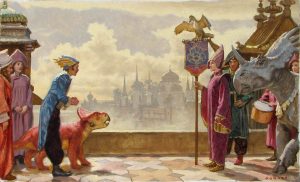I was looking up more information about The Arrival and found a wonderful animation adaptation of it (below). I think it does justice to Tan’s story, although it only focuses on the main character and loses some of the other stories that are embedded in the book (specifically the parts that have different colored gutters; some sacrifices probably had to be made when going from book to animation). I particularly liked the use of sound in the animation — did anyone read the book with sound? Below are some points in the video in which sound was particularly effective for me:
- 3:50, when the main character is with all the other newcomers, getting his information taken for his ID. The constant murmur of people in a large, echoey space while you’re trying to get something done is familiar to me (reminds me of when I pass through Grand Central Terminal).
- The cacauphonous sounds at 1:02, which made me uneasy and indicated the uncertain journey the main character had ahead of him, and the one at 1:23, which indicated to me how this new place might be scary
- The rustle of bed sheets when waking up (7:32), of wrapping photos (0:33), and of tying shoes (7:44) bring to life the details of the main character’s daily life
The animation, from its zooming and panning, also really brought my attention to the grainy photorealistic technique that Tan utilized in his images. Additionally, I appreciate how the animator organized the images, shuffling through the square snapshots of the main character’s experiences and spending more time on splash pages. I think these approaches mimicked the pace of the book well.
The Arrival feels like something I can read over and over again, especially if I’m feeling lost, like I don’t fit in, or when I’m in a new place (job, city, etc.) that is brimming with unfamiliar stimuli. I think without words, Tan’s sole use of images both allows me to sort of know what is going on and affords me greater connection with the story because if I want, I can interpret the images subtly in a way that resonates with me. Or, I can see the story playing out in other people’s lives as well. In other words, The Arrival has a universality from demonstrating a wide array of experiences (which may have been lost in the animation).

